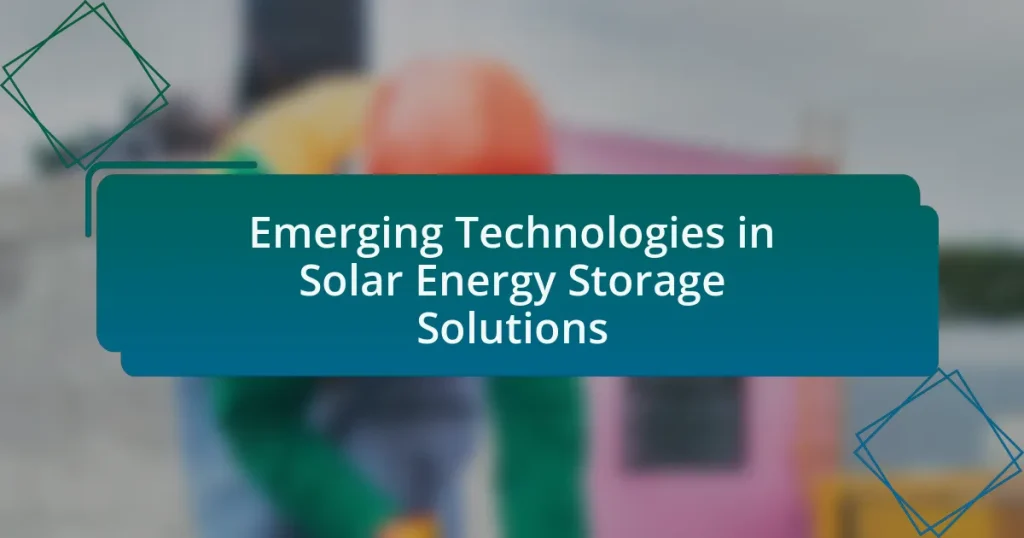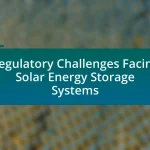Emerging technologies in solar energy storage solutions encompass advanced lithium-ion batteries, solid-state batteries, flow batteries, and thermal energy storage systems. These innovations enhance energy efficiency and storage capacity, addressing the intermittent nature of solar energy and facilitating its integration into the energy grid. Key advancements include improved energy density, longer lifespans, and the incorporation of artificial intelligence for optimized energy management. The article also explores the differences between traditional and emerging storage methods, the environmental impacts of new materials, and successful real-world implementations, highlighting the importance of innovation in promoting renewable energy adoption.
What are Emerging Technologies in Solar Energy Storage Solutions?
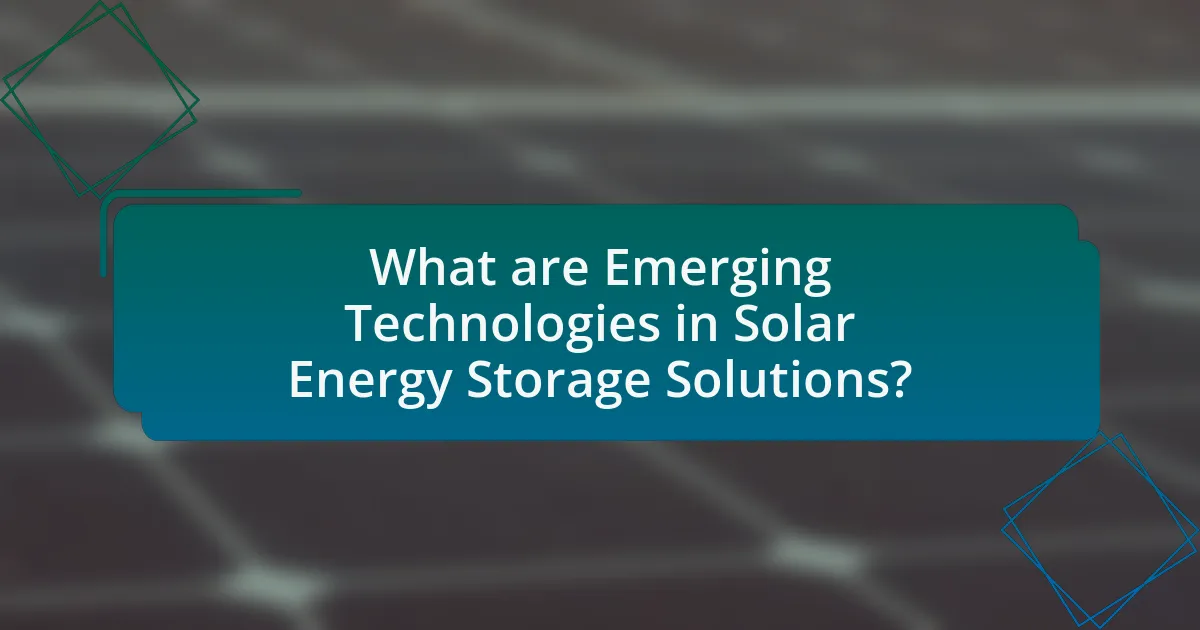

Emerging technologies in solar energy storage solutions include advanced lithium-ion batteries, solid-state batteries, flow batteries, and thermal energy storage systems. These technologies enhance energy efficiency and storage capacity, addressing the intermittent nature of solar energy. For instance, solid-state batteries offer higher energy density and improved safety compared to traditional lithium-ion batteries, while flow batteries provide scalable storage solutions suitable for large-scale applications. Additionally, thermal energy storage systems, such as molten salt storage, allow for the capture and release of solar energy as heat, enabling energy use even when sunlight is not available. These innovations are crucial for integrating solar power into the energy grid and promoting renewable energy adoption.
How do these technologies differ from traditional solar energy storage methods?
Emerging technologies in solar energy storage solutions differ from traditional methods primarily in their efficiency and scalability. Traditional solar energy storage typically relies on lead-acid batteries, which have lower energy density and shorter lifespans, often lasting around 3 to 5 years. In contrast, newer technologies such as lithium-ion batteries and flow batteries offer higher energy densities, longer lifespans of 10 to 15 years, and faster charging capabilities. For instance, lithium-ion batteries can achieve up to 90% round-trip efficiency, significantly outperforming the 70-80% efficiency of lead-acid systems. Additionally, emerging technologies often incorporate advanced materials and smart grid integration, enabling better energy management and utilization compared to conventional storage methods.
What advancements have been made in battery technology for solar energy storage?
Recent advancements in battery technology for solar energy storage include the development of lithium-sulfur batteries, solid-state batteries, and flow batteries. Lithium-sulfur batteries offer higher energy density and lower costs compared to traditional lithium-ion batteries, with research indicating potential energy densities of up to 500 Wh/kg. Solid-state batteries enhance safety and longevity by using solid electrolytes, which can reduce the risk of fires and improve cycle life. Flow batteries, particularly vanadium redox flow batteries, provide scalability and long-duration storage capabilities, making them suitable for large-scale solar energy applications. These innovations are supported by ongoing research and development efforts, such as those from the U.S. Department of Energy, which aims to improve battery efficiency and reduce costs for renewable energy integration.
How do these advancements improve efficiency and capacity?
Advancements in solar energy storage solutions improve efficiency and capacity by enhancing energy retention and reducing losses during storage and retrieval. For instance, innovations such as lithium-sulfur batteries have demonstrated a higher energy density compared to traditional lithium-ion batteries, allowing for more energy to be stored in a smaller space. Additionally, the integration of artificial intelligence in energy management systems optimizes charging and discharging cycles, leading to a more efficient use of stored energy. These improvements are supported by research indicating that lithium-sulfur batteries can achieve up to 500 Wh/kg, significantly surpassing the 150 Wh/kg of conventional lithium-ion batteries, thereby increasing overall capacity and efficiency in solar energy applications.
Why is innovation in solar energy storage important?
Innovation in solar energy storage is crucial because it enhances the efficiency and reliability of solar power systems. Improved storage technologies allow for better management of energy supply and demand, enabling the use of solar energy even when sunlight is not available. For instance, advancements in battery technologies, such as lithium-ion and solid-state batteries, have significantly increased energy density and reduced costs, making solar energy more accessible and practical for widespread use. According to the International Energy Agency, energy storage capacity is projected to grow by over 40% annually, underscoring the importance of innovation in this field to support the transition to renewable energy sources and achieve sustainability goals.
What challenges do current solar energy systems face without advanced storage solutions?
Current solar energy systems face significant challenges without advanced storage solutions, primarily due to their intermittent nature. Solar energy generation is dependent on sunlight, which means that energy production fluctuates throughout the day and is non-existent at night. This inconsistency leads to a mismatch between energy supply and demand, making it difficult to rely solely on solar power for continuous energy needs.
Additionally, without advanced storage, excess energy generated during peak sunlight hours cannot be stored for later use, resulting in wasted potential energy. According to the U.S. Department of Energy, solar energy systems can lose up to 30% of their potential output due to this lack of storage capability. Furthermore, the inability to store energy limits the integration of solar power into the grid, hindering the transition to a more sustainable energy system.
How can emerging technologies address these challenges?
Emerging technologies can address challenges in solar energy storage solutions by enhancing efficiency, reducing costs, and improving scalability. For instance, advancements in battery technologies, such as lithium-sulfur and solid-state batteries, offer higher energy densities and longer lifespans compared to traditional lithium-ion batteries. According to a study published in the journal Nature Energy, solid-state batteries can potentially increase energy density by up to 50%, which directly addresses the challenge of limited storage capacity. Additionally, innovations in artificial intelligence and machine learning optimize energy management systems, enabling better prediction of energy demand and supply, thus improving the overall reliability of solar energy systems. These technologies collectively contribute to overcoming the barriers of efficiency, cost, and scalability in solar energy storage.
What types of emerging technologies are being developed for solar energy storage?
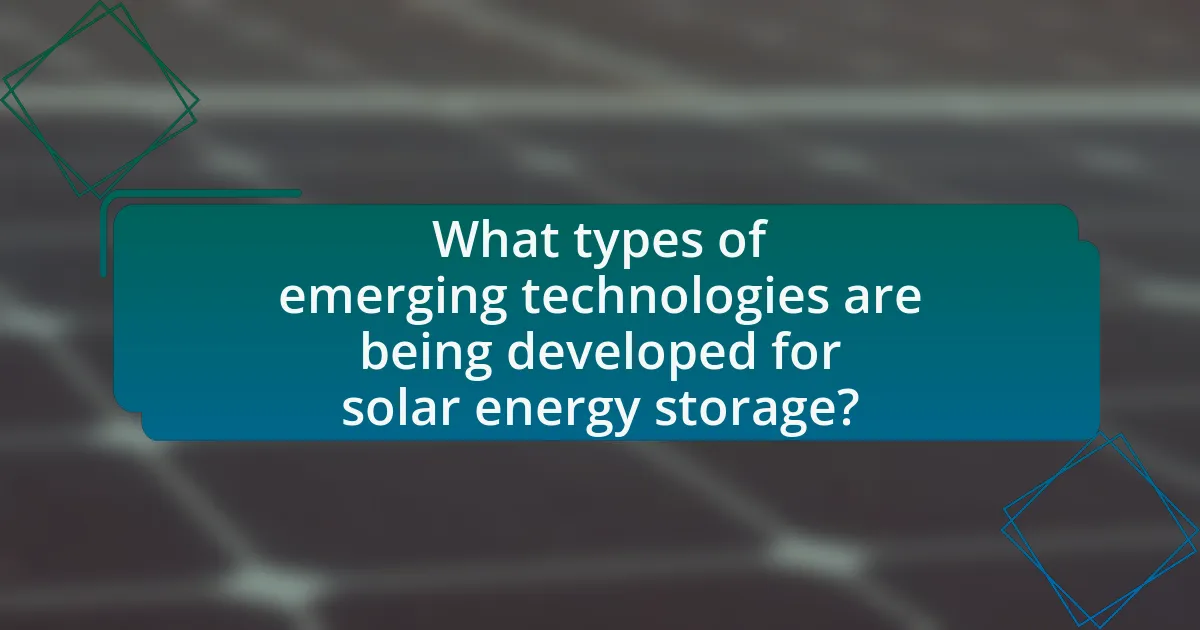

Emerging technologies for solar energy storage include lithium-sulfur batteries, solid-state batteries, and flow batteries. Lithium-sulfur batteries offer higher energy density compared to traditional lithium-ion batteries, potentially increasing storage capacity and efficiency. Solid-state batteries utilize a solid electrolyte, which enhances safety and longevity while reducing the risk of leakage and flammability associated with liquid electrolytes. Flow batteries, on the other hand, allow for scalable energy storage by using liquid electrolytes that can be stored externally, making them suitable for large-scale applications. These advancements are supported by ongoing research and development efforts aimed at improving energy efficiency and reducing costs in solar energy systems.
What are the key categories of solar energy storage technologies?
The key categories of solar energy storage technologies include battery storage, thermal energy storage, and mechanical storage. Battery storage, particularly lithium-ion batteries, is widely used for its efficiency and scalability, allowing for the storage of excess solar energy for later use. Thermal energy storage systems, such as molten salt or phase change materials, store heat generated from solar energy, which can be converted back into electricity when needed. Mechanical storage, including pumped hydro storage and flywheels, utilizes kinetic or potential energy to store and release energy. These categories are essential for enhancing the reliability and efficiency of solar energy systems, as they enable energy to be stored and utilized when solar generation is low.
How do lithium-ion batteries compare to other types of batteries?
Lithium-ion batteries outperform other types of batteries, such as lead-acid and nickel-cadmium, in energy density, cycle life, and efficiency. Specifically, lithium-ion batteries typically offer energy densities of 150-250 Wh/kg, compared to lead-acid batteries, which provide around 30-50 Wh/kg. Additionally, lithium-ion batteries can endure 500-2,000 charge cycles, significantly exceeding the 200-300 cycles of lead-acid batteries. Their efficiency in energy conversion is also higher, often exceeding 90%, while lead-acid batteries usually operate at around 70-80% efficiency. These advantages make lithium-ion batteries the preferred choice for applications in solar energy storage solutions, where space and weight are critical factors.
What role do flow batteries play in solar energy storage solutions?
Flow batteries serve a crucial role in solar energy storage solutions by providing scalable, long-duration energy storage capabilities. These batteries can store excess solar energy generated during the day and release it during periods of low sunlight, thus enhancing the reliability and efficiency of solar power systems. Flow batteries, such as vanadium redox flow batteries, are particularly advantageous due to their ability to decouple energy and power, allowing for flexible sizing based on specific energy needs. This technology supports grid stability and facilitates the integration of renewable energy sources, as evidenced by projects like the 35 MWh vanadium flow battery installation in Dalian, China, which demonstrates their effectiveness in large-scale energy storage applications.
What innovative materials are being used in solar energy storage technologies?
Innovative materials used in solar energy storage technologies include lithium-ion batteries, solid-state batteries, and phase change materials. Lithium-ion batteries are widely utilized due to their high energy density and efficiency, making them suitable for storing solar energy. Solid-state batteries, which use solid electrolytes instead of liquid ones, offer improved safety and longevity. Phase change materials, such as paraffin wax, store thermal energy by changing states, providing an effective means of energy storage for solar thermal applications. These materials enhance the performance and reliability of solar energy storage systems, contributing to the advancement of renewable energy technologies.
How do new materials enhance the performance of solar energy storage systems?
New materials enhance the performance of solar energy storage systems by improving energy density, charge/discharge rates, and cycle stability. For instance, advancements in lithium-sulfur and solid-state batteries have demonstrated significantly higher energy densities compared to traditional lithium-ion batteries, allowing for more energy storage in a smaller footprint. Additionally, materials like graphene and advanced polymers contribute to faster charge/discharge cycles, which increases the efficiency of energy use. Research indicates that solid-state batteries can achieve up to 500 Wh/kg energy density, compared to 150-250 Wh/kg for conventional lithium-ion batteries, thus validating the performance improvements offered by these new materials.
What are the environmental impacts of these new materials?
The environmental impacts of new materials in solar energy storage solutions include reduced carbon emissions, resource depletion, and potential toxicity. These materials, such as advanced lithium-ion batteries and organic photovoltaics, often lead to lower greenhouse gas emissions during their lifecycle compared to traditional fossil fuels. However, the extraction of raw materials like lithium and cobalt can result in habitat destruction and water scarcity. Additionally, some materials may pose risks of leaching toxic substances into the environment if not properly managed at the end of their life cycle. Studies indicate that while these new materials can enhance energy efficiency, their overall environmental footprint must be carefully assessed to mitigate negative impacts.
How are emerging technologies in solar energy storage being implemented in real-world applications?
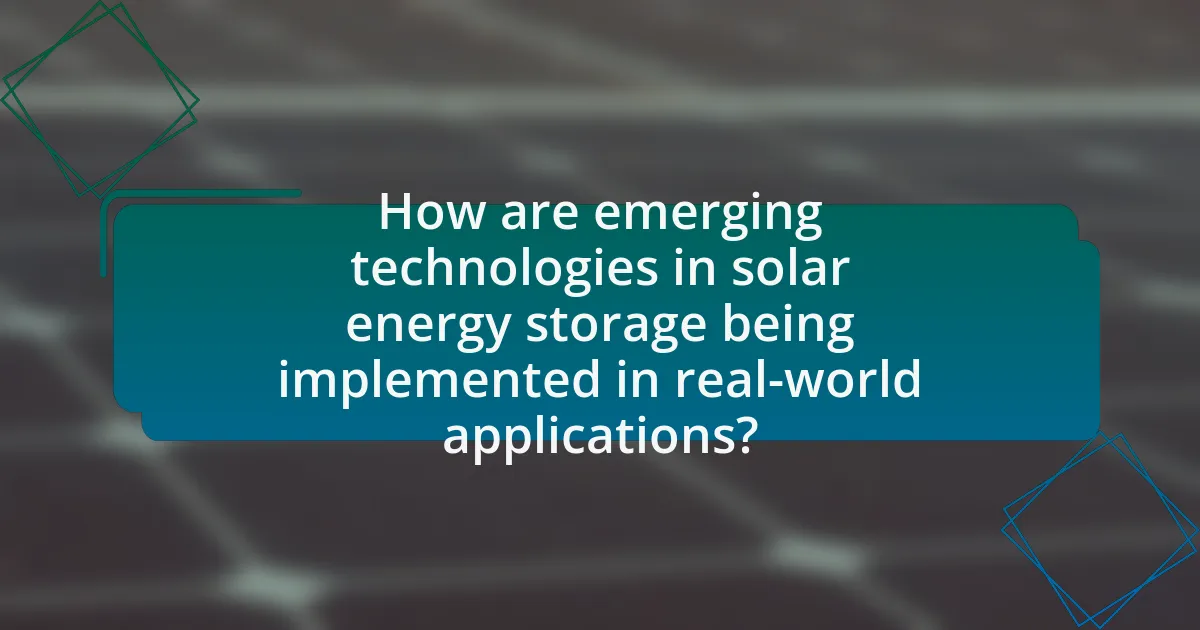

Emerging technologies in solar energy storage are being implemented in real-world applications through advanced battery systems, such as lithium-ion and solid-state batteries, which enhance energy efficiency and storage capacity. For instance, companies like Tesla have deployed their Powerwall systems in residential settings, allowing homeowners to store solar energy for use during peak demand times, thereby reducing reliance on the grid. Additionally, large-scale projects, such as the Hornsdale Power Reserve in Australia, utilize grid-scale battery storage to stabilize energy supply and integrate renewable sources effectively. These implementations demonstrate the practical benefits of emerging technologies in optimizing solar energy utilization and improving energy resilience.
What are some successful case studies of solar energy storage solutions?
Successful case studies of solar energy storage solutions include the Hornsdale Power Reserve in South Australia, which utilizes Tesla’s lithium-ion battery technology to provide grid stability and has a capacity of 150 MW. This facility has demonstrated the ability to respond to grid demands within milliseconds, significantly reducing reliance on fossil fuels and enhancing renewable energy integration. Another notable example is the Kauai Island Utility Cooperative in Hawaii, which employs a combination of solar PV and battery storage systems, allowing the island to achieve over 90% renewable energy generation during certain periods. This project showcases the effectiveness of solar energy storage in remote locations with high energy costs. Additionally, the El Romero Solar Plant in Chile integrates a solar thermal system with molten salt storage, enabling energy dispatchability even during non-sunny hours, thus proving the viability of solar energy storage in large-scale applications.
How have these implementations improved energy management for users?
Implementations of emerging technologies in solar energy storage solutions have significantly improved energy management for users by enhancing efficiency and reliability in energy consumption. These advancements allow users to store excess solar energy generated during peak sunlight hours for use during periods of low generation, thereby optimizing energy usage and reducing reliance on the grid. For instance, lithium-ion batteries, which have become more affordable and efficient, enable users to maximize their solar energy utilization, leading to potential savings of up to 30% on energy bills. Additionally, smart energy management systems integrated with these storage solutions provide real-time monitoring and control, allowing users to make informed decisions about energy consumption and further improve overall energy efficiency.
What lessons can be learned from these case studies?
The lessons learned from case studies on emerging technologies in solar energy storage solutions include the importance of innovation in efficiency and cost reduction. For instance, advancements in lithium-ion battery technology have demonstrated significant improvements in energy density and lifespan, which are critical for enhancing solar energy storage capabilities. Additionally, case studies reveal that integrating artificial intelligence for energy management can optimize storage usage and reduce waste, leading to more sustainable energy practices. These findings underscore the necessity of continuous research and development to address challenges in scalability and grid integration, ultimately contributing to the broader adoption of solar energy solutions.
What are the future trends in solar energy storage technologies?
Future trends in solar energy storage technologies include the advancement of solid-state batteries, increased use of lithium-sulfur batteries, and the integration of artificial intelligence for energy management. Solid-state batteries are expected to enhance energy density and safety, as they replace liquid electrolytes with solid materials, potentially leading to longer lifespans and faster charging times. Lithium-sulfur batteries are gaining attention due to their higher theoretical energy capacity compared to traditional lithium-ion batteries, which could significantly reduce costs and improve efficiency. Additionally, the application of artificial intelligence in energy storage systems allows for optimized energy usage and predictive maintenance, enhancing overall system performance. These trends are supported by ongoing research and development efforts aimed at improving the efficiency, safety, and cost-effectiveness of solar energy storage solutions.
How might advancements in artificial intelligence impact solar energy storage?
Advancements in artificial intelligence can significantly enhance solar energy storage by optimizing energy management and improving battery performance. AI algorithms can analyze vast amounts of data from solar energy systems to predict energy generation and consumption patterns, enabling more efficient charging and discharging cycles of storage systems. For instance, AI can facilitate real-time monitoring and predictive maintenance of batteries, which can extend their lifespan and improve reliability. Research indicates that AI-driven energy management systems can increase the efficiency of solar energy utilization by up to 30%, demonstrating the tangible benefits of integrating AI into solar energy storage solutions.
What role will government policies play in the adoption of these technologies?
Government policies will significantly influence the adoption of emerging solar energy storage technologies by providing regulatory frameworks, financial incentives, and support for research and development. For instance, policies such as tax credits, grants, and subsidies can lower the cost barrier for consumers and businesses, encouraging investment in solar storage solutions. Additionally, regulations that mandate renewable energy usage or set energy efficiency standards can drive the integration of these technologies into the market. Evidence of this impact can be seen in countries like Germany, where government initiatives have led to a substantial increase in solar energy adoption, with solar capacity growing from 1.5 GW in 2000 to over 50 GW by 2020, largely due to supportive policies.
What best practices should be followed when considering solar energy storage solutions?
When considering solar energy storage solutions, it is essential to evaluate the system’s capacity, efficiency, and compatibility with existing solar installations. Assessing the storage capacity ensures that the system can meet energy demands during peak usage times, while efficiency ratings indicate how much energy can be effectively stored and retrieved. Compatibility with current solar technology is crucial to ensure seamless integration and optimal performance.
Additionally, selecting a reputable manufacturer with a proven track record in solar storage technology enhances reliability and longevity. Research shows that systems from established brands often come with better warranties and customer support, which are vital for long-term investment. Furthermore, considering the environmental impact and sustainability of the materials used in the storage solution can contribute to a more eco-friendly energy system.
